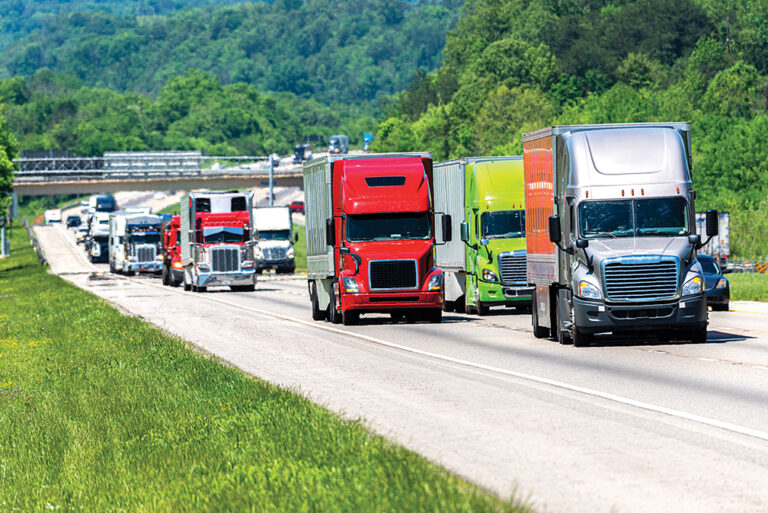Want to talk about a bright, blinking sign of today’s environment for the trucking industry?
Since 1999, according to data provided by FTR, an industry source for transportation intelligence, there’s been a virtual explosion in the number of trucking companies receiving authority to operate as granted by the Federal Motor Carrier Safety Administration (FMCSA).
FTR said 109,340 trucking companies opened for business in 2021. That’s 50,202 more than 2020 (59,538) and 65,787 more than 2018 (43,953), the third-largest year on record since 1999, when 15,597 carriers were granted authority.
“Yes, the explosion of new carrier registrations is certainly a sign of the times,” said Truckload Carriers Association (TCA) Vice President of Government Affairs David Heller. “With capacity being as tight as it is and rates reaching as high as they have, people certainly will not be hesitant to take advantage of this market.”
FTR’s Vice President of Trucking Avery Vise added that the surge in new carriers resulted from a combination of events that occurred basically simultaneously.
“First, the lockdowns in the spring of 2020 displaced many leased owner-operators and company drivers, either through furloughs or sharply reduced miles and, hence, pay,” explained Vise. “At the same time, the Coronavirus Aid, Relief, and Economic Security (CARES) Act offered a financial cushion and seed capital that allowed drivers and leased owner-operators to strike out on their own.”
Vise noted that the industry was already seeing the rise of digital freight platforms, which make it much easier for intermediaries to manage and market the capacity of many very small carriers. In addition, concerns about threats to the leased owner-operator model because of California’s AB 5 and similar initiatives had encouraged some truckload carriers to move away from that model and more toward an intermediary model using independent carriers.
Then, of course there was COVID-19 — and those empty grocery shelves.
“COVID has certainly had it hands in all of this, too,” shared Heller. “The effects of COVID on the supply chain has led to the capacity crunch, which in turn has created an environment that allowed people to get into the industry. Local operations have flourished with the growth of home-delivery models, causing many drivers to transition. Even the threat of the COVID vaccine mandate has most likely made some drivers leave the industry — and in the case of border crossings, some drivers already have.”
All of these factors were simply enablers, however, noted Vise.
“What really sparked the surge was the rebound in consumer spending and the related effects on spot market volume and rates,” he said. “That dynamic encouraged new entrants and began a shift of capacity into the spot market. To a degree, that trend became self-perpetuating because it increasingly starved larger carriers’ freight networks of driver capacity, which had the effect of sending still more freight into the spot market and propping up rates.”
FTR’s estimate, which Vise believes is conservative, is that trucking companies added since July 2020 and still holding authority account for nearly 169,000 truck drivers. Of that total, FTR’s estimate is that about 76,000 carriers operate tractors, not just straight trucks, and account for more than 113,000 drivers.
In the midst of what most trucking stakeholders say is a shortage of 80,000 drivers, more than 70% of these companies are single-driver operations. Whether those drivers were formerly long-haul drivers before gaining their own authority is hard to discern.
Because they are single-driver operations, they almost certainly fall outside of the Bureau of Labor Statistics (BLS) payroll employment figures.
However, Vise said, the BLS figures also do not capture leased owner-operators, and FTR believes that this pool of drivers represents most — but certainly not all — of the drivers associated with new carriers entering the market since July 2020.
“After all,” he said, “leased owner-operators already had trucks, so it was an easier transition than it was for company drivers who had to both buy a truck and get authority.”
Total payroll employment in trucking has essentially fully recovered from the COVID-19 pandemic. Therefore, given the huge number of drivers associated with new carriers, it would take only a small percentage of former company drivers buying trucks and getting authority to indicate that there are more truck drivers today than before the pandemic.
“That does not mean that long-haul trucking has recovered, however,” said Vise. “More detailed BLS payroll jobs data available through November (2021) shows that production/non-supervisory jobs — a category that gets closer to the number of drivers than total employment does — are up nearly 8% since the beginning of the pandemic in local general freight, but down 4.5% for long-distance general freight truckload.”
Medium and large truckload carriers are facing two major headwinds in finding and keeping enough drivers beyond those they have faced for years, according to Vise.
“One is a shift in drivers from long-haul to local. The other is a shift of leased owner-operators and company drivers away from larger carriers and to independent carriers doing business in the spot market and with brokers and 3PLs” he said. “Of course, in some cases, these logistics firms are units of the same trucking companies these drivers previously worked for, but that probably is the exception, not the rule.”
FTR estimates that between March 2020 and December 2021, for-hire trucking companies with 100 or fewer trucks have pulled 4 to 5 percentage points of market share of trucks and drivers away from larger carriers, mostly due to the surge in new entry.
Whether the surge in new trucking companies is good or not so good for the industry is the $64,000 question — but things are likely to slow down sooner or later.
What might be some factors that slow the rate of new carriers?
On a monthly basis, new authorizations are already off the peak period in June through October, but not by much. As long as spot rates remain elevated and stable, Vise said the industry can expect the number of new carriers authorized monthly to continue to outpace what was normal before the pandemic.
“However, we could see several factors, either individually or together, slowing the surge or perhaps even reversing it and sending drivers back to the security of working with larger carriers,” he shared. “The most obvious would be a sharp drop in overall freight volume. We do not expect such a decline, but it certainly is possible, given that consumer stimulus is fading, and consumer prices are rising. A drop in freight would reduce miles and lead to lower spot rates, putting a squeeze on these carriers’ margins.
Another catalyst for lower spot rates and volume would be continued increases in the supply of drivers among larger truckload carriers.
“Although carriers continue to see headwinds in this regard, it might not take much improvement in driver recruiting to take some pressure off the spot market and begin a reversal of pressures that have kept spot rates stubbornly strong,” stated Vise. “Given how much driver capacity has shifted to these new carriers, this dynamic could snowball. We have seen no signs of this happening yet, but the process could be fairly rapid once if and when it starts.”
Higher costs also could spur a cooling of new entry, Vise noted, adding that diesel has been running at the highest prices in years.
“As long as spot rates remain as strong as they are now, carriers should still be profitable even with high diesel prices,” he said. “However, managing cash flow becomes a bigger issue and could prove overwhelming for many very small carriers. Finally, the cost and availability of trucks is likely already becoming a limiting factor, especially in the potential for company drivers to obtain a truck and get authority.”
How will it all roll out? Only time will tell.
Lyndon Finney’s publishing career spans over 55 years beginning with a reporter position with the Southwest Times Record in Fort Smith, Arkansas, in 1965. Since then he’s been a newspaper editor at the Southwest Times Record, served five years as assistant managing editor of the Arkansas Democrat-Gazette in Little Rock and from November 2004 through December 2019 served as editor of The Trucker. Between newspaper jobs he spent 14 years as director of communications at Baptist Health, Arkansas’ largest healthcare system. In addition to his publishing career he served for 46 years as organist at Little Rock’s largest Baptist church.
















I have read your blog about commercial truck insurance, which I have read for a long time. I know trucking insurance is one of the most talked about topics in the USA. The federal government has also made insurance mandatory which can be very difficult for some. I know a few tips to help you to reduce the costs. You can read what I have written at :
https://mayflower.insurance/how-is-truck-insurance-in-florida-changing-the-landscape/
Remarkable surge in new trucking companies reflects shifting industry dynamics amid pandemic impacts. Opportunities and challenges lie ahead, reshaping the future of transportation. Introducing “TaxZerone,” an IRS-authorized e-file service provider facilitating easy and secure filing of various IRS forms, supporting businesses and individuals. Visit: www.taxzerone.com